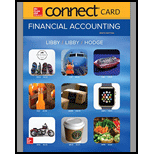
Connect Access Card for Financial Accounting
9th Edition
ISBN: 9781259738678
Author: Robert Libby, Patricia Libby, Frank Hodge Ch
Publisher: McGraw-Hill Education
expand_more
expand_more
format_list_bulleted
Concept explainers
Question
Chapter 6, Problem 6.19E
1.a.
To determine
Record the
1.b.
To determine
Prepare the
2.
To determine
Show how the accounts receivable related accounts should be shown on the income statement and
3.
To determine
Explain whether the percent rate of 1.5 is reasonable.
Expert Solution & Answer
Want to see the full answer?
Check out a sample textbook solution
Students have asked these similar questions
A university's bookstore has an average textbook price of $78.50. Variable costs are $42.75 per textbook and fixed costs total $156,000. How many textbooks must be sold to provide an operating income of $47,500? How many textbooks would have to be sold if fixed costs increased by 15%? (round up calculation to the nearest number)
I need the correct answer to this financial accounting problem using the standard accounting approach.
Fairview Industries recently purchased 128,000 units of raw material for $576,000. Four units of raw materials are budgeted for use in each finished good manufactured, with the raw material standard set at $24.00 for each completed product. Fairview manufactured 31,250 finished units during the period just ended and used 127,500 units of raw material. If management is concerned about the timely reporting of variances in an effort to improve cost control and bottom-line performance, what would the materials purchase price variance be?
Chapter 6 Solutions
Connect Access Card for Financial Accounting
Ch. 6 - Prob. 1QCh. 6 - What is gross profit or gross margin on sales? In...Ch. 6 - What is a credit card discount? How does it affect...Ch. 6 - Prob. 4QCh. 6 - Prob. 5QCh. 6 - Differentiate accounts receivable from notes...Ch. 6 - Which basic accounting principle is the allowance...Ch. 6 - Using the allowance method, is bad debt expense...Ch. 6 - Prob. 9QCh. 6 - Prob. 10Q
Ch. 6 - Prob. 11QCh. 6 - Prob. 12QCh. 6 - Prob. 13QCh. 6 - Prob. 14QCh. 6 - Briefly explain how the total amount of cash...Ch. 6 - Prob. 16QCh. 6 - Sales discounts with terms 2/10, n/30 mean: a. 10...Ch. 6 - Gross sales total 300,000, one-half of which were...Ch. 6 - A company has been successful in reducing the...Ch. 6 - When a company using the allowance method writes...Ch. 6 - You have determined that Company X estimates bad...Ch. 6 - Prob. 6MCQCh. 6 - Which of the following is not a step toward...Ch. 6 - When using the allowance method, as bad debt...Ch. 6 - Which of the following best describes the proper...Ch. 6 - Prob. 10MCQCh. 6 - Prob. 6.1MECh. 6 - Prob. 6.2MECh. 6 - Recording Bad Debts Prepare journal entries for...Ch. 6 - Prob. 6.4MECh. 6 - Determining the Effects of Credit Policy Changes...Ch. 6 - Prob. 6.6MECh. 6 - Prob. 6.7MECh. 6 - Prob. 6.1ECh. 6 - Reporting Net Sales with Credit Sales, Sales...Ch. 6 - Reporting Net Sales with Credit Sales, Sales...Ch. 6 - Determining the Effects of Credit Sales, Sales...Ch. 6 - Prob. 6.5ECh. 6 - Reporting Bad Debt Expense and Accounts Receivable...Ch. 6 - Recording Bad Debt Expense Estimates and...Ch. 6 - Recording Bad Debt Expense Estimates and...Ch. 6 - Prob. 6.9ECh. 6 - Prob. 6.10ECh. 6 - Computing Bad Debt Expense Using Aging Analysis...Ch. 6 - Recording and Reporting a Bad Debt Estimate Using...Ch. 6 - Recording and Reporting a Bad Debt Estimate Using...Ch. 6 - Prob. 6.14ECh. 6 - Prob. 6.15ECh. 6 - Inferring Bad Debt Write-Offs and Cash Collections...Ch. 6 - Inferring Bad Debt Write-Offs and Cash Collections...Ch. 6 - Prob. 6.18ECh. 6 - Prob. 6.19ECh. 6 - Prob. 6.20ECh. 6 - Recording, Reporting, and Evaluating a Bad Debt...Ch. 6 - Prob. 6.22ECh. 6 - Prob. 6.23ECh. 6 - Interpreting tho Effects of Salos Declines and...Ch. 6 - Prob. 6.25ECh. 6 - Prob. 6.26ECh. 6 - Prob. 6.27ECh. 6 - Prob. 6.1PCh. 6 - Recording Bad Debts and Interpreting Disclosure of...Ch. 6 - Determining Bad Debt Expense Based on Aging...Ch. 6 - Preparing an Income Statement and Computing the...Ch. 6 - Prob. 6.5PCh. 6 - Prob. 6.6PCh. 6 - Prob. 6.7PCh. 6 - Reporting Net Sales and Expenses with Discounts,...Ch. 6 - Prob. 6.2APCh. 6 - Determining Bad Debt Expense Based on Aging...Ch. 6 - Prob. 6.4APCh. 6 - Prob. 6.5APCh. 6 - Prob. 6.1CONCh. 6 - Finding Financial Information Refer to the...Ch. 6 - Finding Financial Information Refer to the...Ch. 6 - Prob. 6.3CPCh. 6 - Prob. 6.4CPCh. 6 - Prob. 6.5CP
Knowledge Booster
Learn more about
Need a deep-dive on the concept behind this application? Look no further. Learn more about this topic, accounting and related others by exploring similar questions and additional content below.Similar questions
arrow_back_ios
SEE MORE QUESTIONS
arrow_forward_ios
Recommended textbooks for you
 Cornerstones of Financial AccountingAccountingISBN:9781337690881Author:Jay Rich, Jeff JonesPublisher:Cengage LearningPrinciples of Accounting Volume 1AccountingISBN:9781947172685Author:OpenStaxPublisher:OpenStax College
Cornerstones of Financial AccountingAccountingISBN:9781337690881Author:Jay Rich, Jeff JonesPublisher:Cengage LearningPrinciples of Accounting Volume 1AccountingISBN:9781947172685Author:OpenStaxPublisher:OpenStax College College Accounting, Chapters 1-27AccountingISBN:9781337794756Author:HEINTZ, James A.Publisher:Cengage Learning,
College Accounting, Chapters 1-27AccountingISBN:9781337794756Author:HEINTZ, James A.Publisher:Cengage Learning, Financial And Managerial AccountingAccountingISBN:9781337902663Author:WARREN, Carl S.Publisher:Cengage Learning,
Financial And Managerial AccountingAccountingISBN:9781337902663Author:WARREN, Carl S.Publisher:Cengage Learning,

Cornerstones of Financial Accounting
Accounting
ISBN:9781337690881
Author:Jay Rich, Jeff Jones
Publisher:Cengage Learning

Principles of Accounting Volume 1
Accounting
ISBN:9781947172685
Author:OpenStax
Publisher:OpenStax College


College Accounting, Chapters 1-27
Accounting
ISBN:9781337794756
Author:HEINTZ, James A.
Publisher:Cengage Learning,

Financial And Managerial Accounting
Accounting
ISBN:9781337902663
Author:WARREN, Carl S.
Publisher:Cengage Learning,
Accounts Receivable and Accounts Payable; Author: The Finance Storyteller;https://www.youtube.com/watch?v=x_aUWbQa878;License: Standard Youtube License